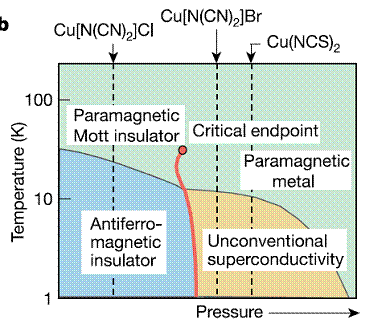 In 2005, Kagawa, Kawamoto, and Kanoda published a beautiful paper in Nature which did a scaling analysis of the conductivity near the critical point. From the figure below they could the extract critical exponents show (delta,beta,gamma)=(2,1,1). These values did not
In 2005, Kagawa, Kawamoto, and Kanoda published a beautiful paper in Nature which did a scaling analysis of the conductivity near the critical point. From the figure below they could the extract critical exponents show (delta,beta,gamma)=(2,1,1). These values did notcorrespond to any known universality class. This is in distinct contrast to the critical exponents found for the corresponding metal-insulator transition for vanadium sesquioxide (V2O3) doped with chromium. In that case the exponents were those for the three dimensional Ising transition (liquid-gas transition).

Subsequently, Imada investigated theoretically how this universality class could emerge due to a marginal quantum critical region near a Mott transition. Misawa and Imada found how this class corresponded to the marginal point between the Ising transition and the topological transition of the Fermi surface.
I remember someone telling me there were problems with this theory
and so hopefully someone can write a comment about that.
So another example how the organic charge transfer salts are a
playground for emergent phenomena arising from quantum many-body physics.




No comments:
Post a Comment